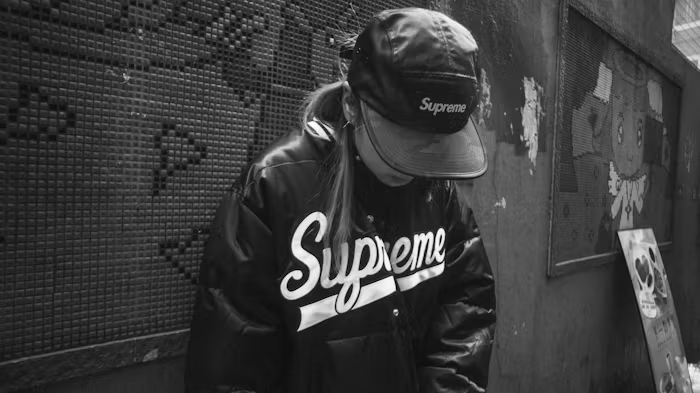In the last four decades, streetwear has transformed from a niche subculture into a dominant force shaping global fashion. What began as a grassroots aesthetic — rooted in skate parks, hip-hop block parties, and surf communities — has ascended to haute couture runways and luxury boutiques. This comprehensive exploration of the evolution of streetwear examines its origins, key milestones, and the cultural forces that propelled it from underground scenes to red-carpet prestige.

Origins: Roots in Skate, Surf, and Hip-Hop Culture
Streetwear’s story starts in the 1970s and 1980s, when young surfers in Southern California and skateboarders in New York City sought clothing that matched their active lifestyles and DIY attitudes. Brands such as Vision Street Wear and Santa Cruz printed bold graphics on T-shirts, hoodies, and sneakers — garments designed for function but loaded with personality. Simultaneously, burgeoning hip-hop artists in the Bronx embraced tracksuits, Kangol hats, and Adidas sneakers as both practical attire and symbols of creative rebellion. These parallel streams converged in urban centers, laying the groundwork for a style defined by comfort, individuality, and cultural expression.
The 1990s: Birth of Iconic Labels and the DIY Ethos
By the early 1990s, independent designers channeled the energy of skate parks and block parties into limited-edition apparel. Shawn Stüssy, a surfer-turned-designer, pioneered the concept of branding by scrawling his signature logo across T-shirts and caps. His eponymous label, Stüssy, became a cult favorite among tastemakers seeking authenticity. Around the same time, James Jebbia launched Supreme in downtown Manhattan, offering hand-picked skate decks alongside hoodies stamped with the crisp red-box logo. These pioneers embraced small-batch production, fostering a sense of exclusivity and community that remains central to streetwear’s allure.
Early 2000s: Skate-Punk Grit Meets Celebrity Endorsement
As internet forums and fashion blogs proliferated, streetwear’s underground credibility caught the eye of musicians and actors. Rap icons like Pharrell Williams and Jay-Z began collaborating with brands such as A Bathing Ape (BAPE), lending celebrity swagger to shark-hoodies and camo-prints. At the same time, skate brands like Baker and Girl expanded beyond decks to apparel, merging punk-rock graphics with laid-back fits. The DIY, anti-establishment ethos thrived online, where message boards and early e-commerce sites connected global communities of collectors, boosting demand for exclusive drops and rare colorways.
Mid-2000s to 2010s: From Niche to Mainstream
Streetwear’s leap into mainstream consciousness accelerated in the mid-2000s, driven by collaborations that blurred boundaries between sportswear, luxury, and art. Nike’s limited releases with Offspring and Complex magazine set the stage for hype-driven product launches. Meanwhile, European designers like Hedi Slimane at Dior Homme introduced slimmer silhouettes that married couture tailoring with streetwise aesthetics — ushering in a new era of cross-pollination. By the 2010s, streetwear fashion had become a staple of menswear weeks in Paris, New York, and Tokyo, signaling its irreversible ascent.
High-Fashion Endorsement: Luxury Houses Embrace the Streets
Perhaps no moment highlights streetwear’s elevation more than Louis Vuitton’s 2017 partnership with Supreme. Under artistic director Virgil Abloh — himself a longtime streetwear tastemaker — the collaboration merged Louis Vuitton’s monogram with Supreme’s red box, igniting lines around city blocks worldwide. Abloh’s own label, Off-White, further solidified the fusion of street credibility and runway prestige, selling industrial-belt belts and deconstructed hoodies for luxury price points. Today, brands like Balenciaga, Dior, and Gucci routinely incorporate oversized hoodies, graphic Tees, and sneaker-silhouettes into their collections, confirming streetwear’s indelible impact on high fashion.
The Digital Revolution: Hype Culture, Drops, and Resale Markets
The proliferation of social media, mobile apps, and online marketplaces turbocharged streetwear’s growth in the 2010s and beyond. Brands adopted “drop culture” — announcing limited releases with countdown timers and cryptic teasers on Instagram and Twitter. Consumers camped outside stores or logged on at midnight to secure coveted pieces. Simultaneously, resale platforms such as StockX, GOAT, and Grailed transformed rare hoodies and sneakers into investable commodities. This symbiotic relationship between scarcity and digital community engagement fueled global demand, expanded secondary markets, and introduced real-time analytics on consumer behavior.
Global Fusion: Diverse Influences and Cross-Cultural Exchange
While streetwear’s origins lie in American skate and hip-hop culture, its modern expression is profoundly global. Tokyo’s A Bathing Ape set off Japan’s vibrant street fashion scene, influencing brands like Visvim and Neighborhood. European labels such as Officine Générale and Ami Paris infuse Parisian elegance with laid-back sensibilities. Meanwhile, African and Latin American designers are emerging, blending local textiles and traditional craftsmanship with street-inflected silhouettes. This cross-cultural dialogue enriches the streetwear lexicon, introducing innovative prints, sustainable fabrics, and region-specific narratives to an ever-evolving style conversation.
Sustainability and the Future of Streetwear
As streetwear enters its fifth decade, a new set of challenges and opportunities emerges. Consumers increasingly demand eco-friendly materials, transparent supply chains, and ethical labor practices. Pioneering brands are responding with recycled polyester hoodies, organic cotton Tees, and zero-waste design processes. Limited-edition drops are giving way to made-to-order models that reduce overproduction. Meanwhile, 3D printing and digital fashion concepts hint at a future where customization and virtual wardrobes rein in environmental impact. The next chapter of streetwear will hinge on balancing exclusivity and hype with responsibility and inclusivity.
From Sidewalks to Runways, Streetwear’s Lasting Legacy
The evolution of streetwear from underground subculture to high-fashion phenomenon underscores the dynamic interplay between youth culture, creativity, and commerce. What started as utilitarian gear for skaters and rappers has morphed into a global language of self-expression, innovation, and social connectivity. By harnessing limited drops, celebrity collaborations, and digital communities, streetwear brands have rewritten the rules of luxury and democratized access to prestigious aesthetics. As it adapts to new technologies, sustainability imperatives, and diverse cultural voices, streetwear will continue to redefine fashion’s frontiers. One thing is certain: the streets will keep inspiring the runways, ensuring this vibrant movement remains at the forefront of style for decades to come.










